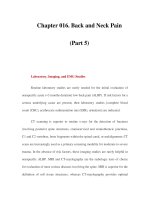Chapter 084. Head and Neck Cancer (Part 2) ppt
Bạn đang xem bản rút gọn của tài liệu. Xem và tải ngay bản đầy đủ của tài liệu tại đây (41.06 KB, 5 trang )
Chapter 084. Head and Neck Cancer
(Part 2)
Clinical Presentation and Differential Diagnosis
Most head and neck cancers occur after age 50, although these cancers can
appear in younger patients, including those without known risk factors. The
manifestations vary according to the stage and primary site of the tumor. Patients
with nonspecific signs and symptoms in the head and neck area should be
evaluated with a thorough otolaryngologic exam, particularly if symptoms persist
longer than 2–4 weeks.
Cancer of the nasopharynx typically does not cause early symptoms.
However, on occasion it may cause unilateral serous otitis media due to
obstruction of the eustachian tube, unilateral or bilateral nasal obstruction, or
epistaxis. Advanced nasopharyngeal carcinoma causes neuropathies of the cranial
nerves.
Carcinomas of the oral cavity present as nonhealing ulcers, changes in the
fit of dentures, or painful lesions. Tumors of the tongue base or oropharynx can
cause decreased tongue mobility and alterations in speech. Cancers of the
oropharynx or hypopharynx rarely cause early symptoms, but they may cause sore
throat and/or otalgia.
Hoarseness may be an early symptom of laryngeal cancer, and persistent
hoarseness requires referral to a specialist for indirect laryngoscopy and/or
radiographic studies. If a head and neck lesion treated initially with antibiotics
does not resolve in a short period, further workup is indicated; to simply continue
the antibiotic treatment may be to lose the chance of early diagnosis of a
malignancy.
Advanced head and neck cancers in any location can cause severe pain,
otalgia, airway obstruction, cranial neuropathies, trismus, odynophagia, dysphagia,
decreased tongue mobility, fistulas, skin involvement, and massive cervical
lymphadenopathy, which may be unilateral or bilateral. Some patients have
enlarged lymph nodes even though no primary lesion can be detected by
endoscopy or biopsy; these patients are considered to have carcinoma of unknown
primary (Fig. 84-1). If the enlarged nodes are located in the upper neck and the
tumor cells are of squamous cell histology, the malignancy probably arose from a
mucosal surface in the head or neck. Tumor cells in supraclavicular lymph nodes
may also arise from a primary site in the chest or abdomen.
Figure 84-1
Evaluation of a patient with cervical adenopathy
without a primary
mucosal lesion; a diagnostic workup. FNA, fine-needle aspiration.
The physical examination should include inspection of all visible mucosal
surfaces and palpation of the floor of mouth and tongue and of the neck. In
addition to tumors themselves, leukoplakia (a white mucosal patch) or
erythroplakia (a red mucosal patch) may be observed; these "premalignant" lesions
can represent hyperplasia, dysplasia, or carcinoma in situ. All visible or palpable
lesions should be biopsied. Further examination should be performed by a
specialist. Additional staging procedures include CT of the head and neck to
identify the extent of the disease. Patients with lymph node involvement should
have chest radiography and a bone scan to screen for distant metastases. The
definitive staging procedure is an endoscopic examination under anesthesia, which
may include laryngoscopy, esophagoscopy, and bronchoscopy; during this
procedure, multiple biopsy samples are obtained to establish a primary diagnosis,
define the extent of primary disease, and identify any additional premalignant
lesions or second primaries.
Head and neck tumors are classified according to the TNM system of the
American Joint Committee on Cancer. This classification varies according to the
specific anatomic subsite (Tables 84-1 and 84-2). Distant metastases are found in
<10% of patients at initial diagnosis, but in autopsy series, microscopic
involvement of the lungs, bones, or liver is more common, particularly in patients
with advanced neck lymph node disease. Modern imaging techniques may
increase the number of patients with clinically detectable distant metastases in the
future.









